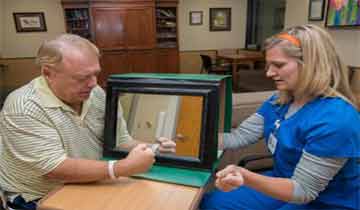Types of Mirror Therapy Exercises for Stroke Patients
Different types of mirror therapy stroke exercises can be used depending on what the aim of the mirror therapy is. Mirror box therapy may benefit you if you have moderate or severe upper limb paresis. If you already have regained a lot of use of your affected arm, it may be better to just exercise this arm as per normal.
During mirror therapy exercises, make sure that your environment is distraction free to allow you to have sustained attention and concentration in order to perceive the vivid illusion. The vividness of the ‘mirror illusion’ influences results, so before starting therapy make sure you can clearly perceive the mirrored image as your affected limb.
Once you have decided mirror therapy is for you, depending on your pain, disability state and aim, choose an appropriate activity to perform. If you are carrying out hand therapy for stroke, this could range from just looking at the mirror image, to finger movements, or taking weight through the hand.
Aim: To Improve Motor Function

If your aim is to improve motor function, functional movements should be practiced. Many studies have measured motor function and found that it improves among participants receiving mirror therapy. Exercise should start with unilateral movement on the unaffected side and progress to bilateral movement.
Hand therapy for stroke could progress from simple finger flexion and extension to tasks such as gripping a cup. For legs, you could start with small movements of the toes or ankles and progress to rolling a ball forwards and back.
Aim: To Correct Neglect or Reduced Sensation
If your aim is to help correct neglect or reduced sensation, you should work on observation of the limb and bilateral sensory stimuli. Just watching the opposite limb reflected in the mirror may help to increase attention to the affected limb but you need to make sure you can see the limb fully. Dohle et al. (2009) found an improvement in neglect after a six-week intervention of mirror box therapy.
Different tactile materials can be used to provide different sensations to the skin. Alternate between soft materials such as silk and rough such as a toothbrush. It is important that the same sensations are applied to both limbs at once so an assistant will be needed for this.
Aim: To Improve Tone
If your aim is to improve tone, unilateral motor exercises with the unaffected limb can be performed. In case of severe muscle spasticity, preliminary stretches may be necessary before positioning the limb. If the arm is still tight, the position of the mirror can also be adjusted to point more diagonally towards the unaffected limb. Exercises should focus on observing the limb in relaxed positions.
If the aim is to improve pain, the exercises should start with unilateral motor and sensory exercises with the unaffected limb.
*Do note that pain or tone may both be too severe to allow movement of the affected limb to start with but this can be introduced gradually in time.